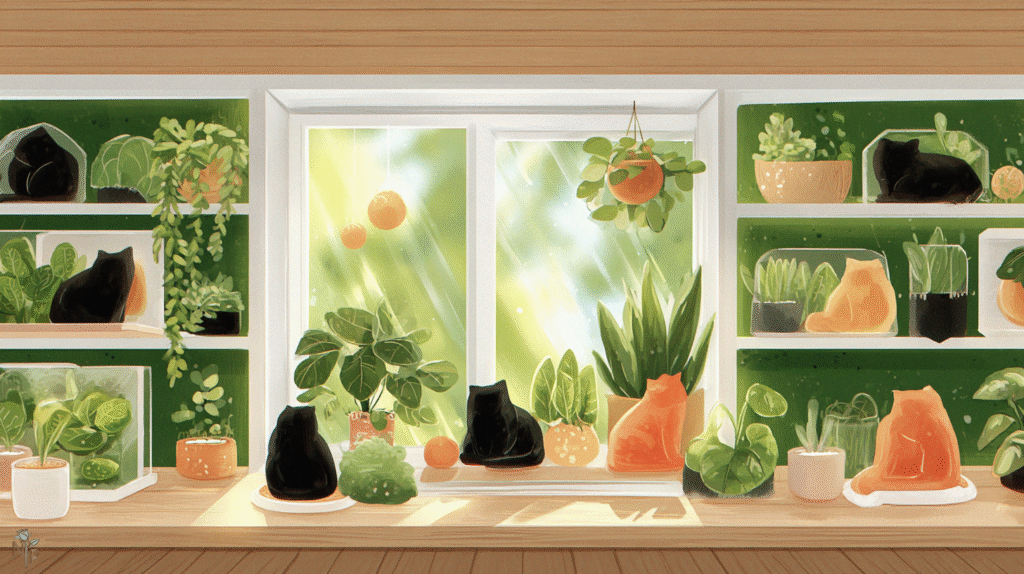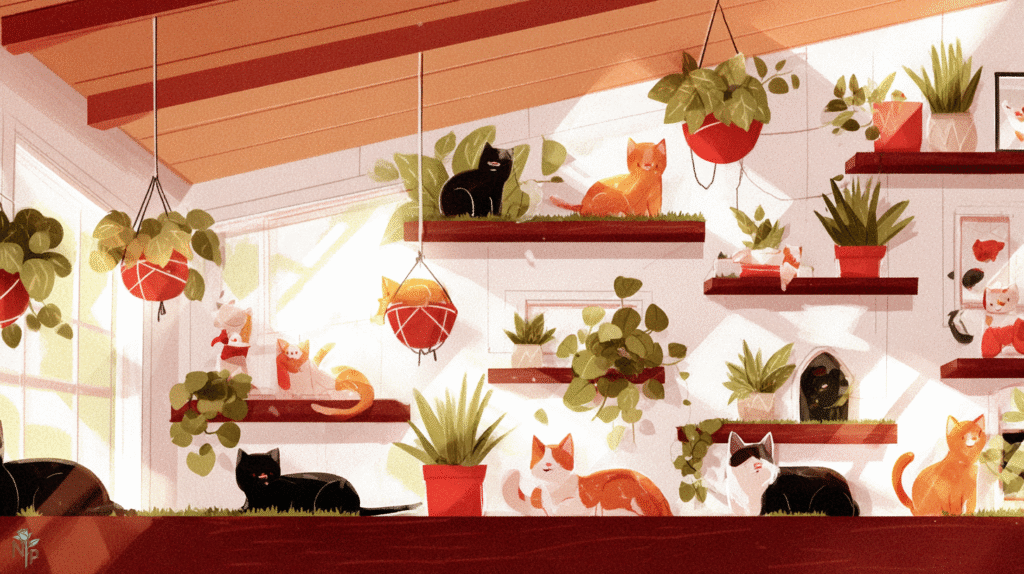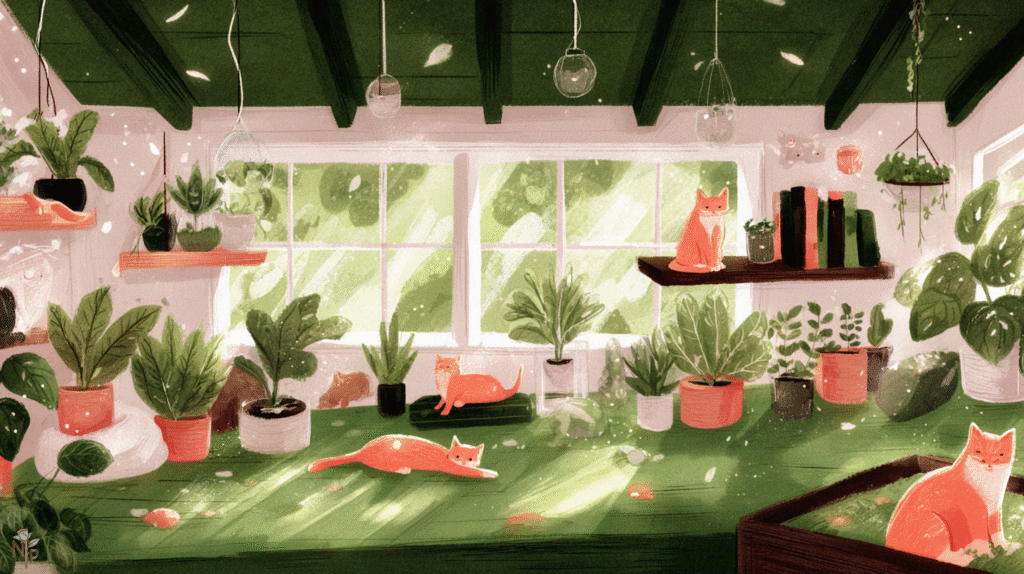My cat Pancake ate half my monstera before I realized it was toxic. $300 emergency vet visit later (she was fine, just dramatic), I swore off houseplants forever. That lasted exactly one week before I saw a gorgeous fiddle leaf fig at Home Depot.
Three years later, I have 52 plants and two cats who haven’t poisoned themselves once. My apartment looks like a jungle, my cats have their own cat grass bar, and nobody’s died. Turns out you can have cats AND plants – you just need to be smarter than I was with that monstera.
After nearly poisoning Pancake, accidentally creating a cat playground with toxic plants, and spending way too much money replacing eaten specimens, I finally figured out how to have a legitimate indoor jungle that won’t kill my cats. Here’s exactly how to do it without the vet bills.

Step 1: Choosing Safe Plants That Actually Look Good
The Non-Toxic Showstoppers
Forget that sad looking spider plant everyone recommends. Here are cat-safe plants that actually make your space look like a jungle:
Parlor Palm: Gets 6 feet tall, looks tropical, cats can chew it without dying. Mine is 4 feet and Pancake sleeps under it daily.
Boston Fern: Hanging baskets of cascading green. Cats love batting at the fronds. Non-toxic and humidity-loving so bathroom perfect.
Ponytail Palm: Not actually a palm, looks like Dr. Seuss designed it. Thick trunk cats can’t destroy, leaves they can safely nibble.
Prayer Plants (Maranta/Calathea): Moving leaves entertain cats for hours. All varieties cat-safe. My Calathea orbifolia has leaves bigger than Pancake’s head.
Peperomia varieties: Hundreds of types, all safe, some look like tiny watermelons. Collection potential without death risk.
The Toxic Ones to Absolutely Avoid
Learned these the hard way or from friends’ disasters:
- Monstera (my $300 mistake)
- Pothos (extremely common, very toxic)
- Snake plants (ironic since cats love grass-like things)
- Peace lilies (deadly to cats)
- Fiddle leaf fig (mild toxicity but why risk it)
- ZZ plants (whole plant is toxic)
The Gray Area Plants
Some plants are “mildly toxic” causing mouth irritation but not death. I still avoid them because Pancake is a nibbler and her sister Waffle eats everything. Not worth even mild discomfort.
Step 2: Strategic Plant Placement
Creating Vertical Layers
Cats are floor and furniture creatures. Plants can live in the air space. My setup:
- Ceiling hooks for hanging baskets (8 Boston ferns creating a canopy)
- Wall-mounted shelves at 5+ feet (cats can’t jump that high from ground)
- Tall plant stands (36 inches minimum)
- Macrame hangers at varying heights
Looks like a jungle, cats can’t reach 80% of it.
The Sacrificial Plant Strategy
I keep cat grass and catnip at ground level as sacrifice plants. Cats focus on these, leave others alone. Like giving a toddler their own special drawer to raid. Works 90% of the time.
My cat grass station:
- Three pots rotating weekly (one growing, one ready, one dying)
- On a waterproof mat (they make a mess)
- Near their favorite window
- Away from other plants to avoid confusion
Safe Zones and No-Go Zones
Safe zones (cat accessible):
- Spider plants on coffee table
- Cat grass obviously
- Parlor palm in corner (too big to knock over)
- Peperomias on low shelf
No-go zones (even though plants are safe):
- Bedroom (dirt in bed = no)
- Kitchen counters (hygiene)
- Bathroom counter (knocked over too many)
Step 3: Cat-Proofing Your Plants
Deterrent Methods That Actually Work
Citrus peels: Cats hate citrus. Orange peels around plants work for about a week. Annoying to replace but effective.
Aluminum foil: Crinkly and weird texture. Worked until Waffle decided she loved it. Now she sleeps on foil. Your results may vary.
Double-sided tape: Sticky paws = unhappy cats. Worked great until it collected so much fur it wasn’t sticky. High maintenance solution.
Rock mulch: Large river rocks on soil prevents digging. Also looks nice. This is my go-to now.
Physical Barriers
Clear acrylic shields: Custom cut from hardware store. Created barriers around floor plants. Cats can see plants but can’t access. Looks like plant museum displays.
Chicken wire cloches: For newly planted stuff. Ugly but temporary until plants establish.
Strategic furniture placement: Bookshelf blocking access to window plants. Coffee table creating moat around floor plants.
Training (Sort Of)
Spray bottle worked for two days. Then Pancake learned to close her eyes and power through. Now she likes being sprayed. Cats are weird.
What actually worked:
- Consistency (removing them every single time)
- Redirection to cat grass
- Praise when they choose appropriate plants
- Accepting some casualties

Step 4: Building the Jungle Systematically
Start with the Foundation Plants
Don’t buy 30 plants at once (I did, chaos ensued). Start with 3-5 large, established safe plants:
- One tall floor plant (parlor palm)
- One hanging plant (Boston fern)
- One statement plant (large Calathea)
Let cats adjust, see what they mess with, adapt placement.
Add Layers Gradually
Month 1: Foundation plants only Month 2: Add wall shelves with small plants Month 3: More hanging plants Month 4: Fill in gaps
This gives you time to see what works and cats time to adjust. Less overwhelming for everyone.
Creating Microclimates
Group plants by needs, makes care easier:
- Bathroom: Ferns and prayer plants (humidity lovers)
- Living room window: Palms and Peperomias (bright light)
- Bedroom corner: Low-light tolerant safe plants
Step 5: Maintaining Plant and Cat Harmony
Daily Monitoring
Every morning I check:
- Water needs (before cats are awake and “helping”)
- Nibble damage (redirect to cat grass if needed)
- Knocked over pots (Waffle’s specialty)
- Soil disturbance (Pancake thinks everything’s a litter box)
Takes 5 minutes, prevents disasters.
Weekly Plant Care Routine
Sundays: Deep watering day. Cats locked in bedroom with treats. No “help” needed.
Wednesdays: Quick water check, misting, dead-heading. Cats supervise from floor.
Daily: Rotate plants for even growth, check for pest issues, admire jungle while cats judge me.
The Pest Control Dilemma
Can’t use toxic pesticides with cats. My solutions:
- Neem oil spray (safe when dry but cats hate the smell)
- Diatomaceous earth for soil gnats (food grade only)
- Sticky traps up high where cats can’t reach
- Manual removal (gross but effective)
- Quarantine new plants for 2 weeks
Creating Cat Entertainment Zones
The Window Garden
East window setup:
- Cat grass forest (5 pots at varying heights)
- Catnip plant (contained in cage-like structure)
- Wheatgrass flat for lounging
- Bird feeder outside for entertainment
Cats spend hours here, ignore other plants completely.
Interactive Plant Elements
Sturdy palms: Cats brush against them like outdoor cats with trees Hanging spider plants: Safe to bat at, fun movement Cat grass at different heights: Creates levels for grazing Prayer plants: Moving leaves = cat TV
The Outdoor Connection
Brought outdoor elements inside safely:
- Large branches (baked to kill bugs) for climbing
- Rock garden section for texture
- Pine cones (supervised play only)
- Grass patch in shallow tray
My Current Setup That Works
Living Room Jungle
- 22 plants at various heights
- Nothing toxic within reach
- Cat grass station by window
- Parlor palm corner jungle gym
- 8 hanging Boston ferns creating canopy
Bathroom Oasis
- 6 humidity-loving prayer plants on shelves
- Boston fern in shower (cats can’t reach)
- Parlor palm by tub (cats drink from water tray)
Bedroom Minimal Setup
- Two hanging Peperomias only
- No floor plants (midnight zoomies)
- Cat grass on window for morning nibbles
Lessons Learned the Hard Way
The Expensive Mistakes
- $300 vet bill (monstera incident)
- $150 in toxic plants donated to friends
- $75 in “cat deterrent” products that didn’t work
- $200 in destroyed safe plants before proper placement
The Success Metrics
- Zero vet visits in 2 years
- 52 thriving plants
- Two healthy, entertained cats
- Apartment that looks amazing
- Only lost 3 plants to cats this year (acceptable casualties)
The Realistic Expectations
Some plants will get nibbled. Some dirt will get scattered. Occasionally a pot gets knocked over. This is life with cats and plants. Perfection isn’t the goal – coexistence is.

The Bottom Line
Creating a cat-friendly indoor jungle is totally possible. It requires:
- Research on toxicity (when in doubt, don’t)
- Strategic placement (up high or behind barriers)
- Sacrificial plants (cat grass is your friend)
- Patience (cats and plants both need adjustment time)
- Acceptance (some casualties are inevitable)
My apartment went from plant-free after Pancake’s monstera incident to a 52-plant jungle. The cats are entertained, not poisoned. The plants (mostly) survive their attempts at destruction. And my space looks like the jungle of my dreams, just with a few teeth marks and the occasional cat grass massacre.
Just remember: start slow, research everything, and accept that your cats will always find the one plant you forgot to cat-proof. It’s their superpower.






